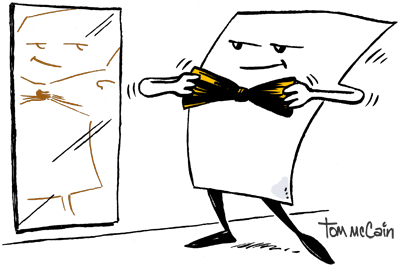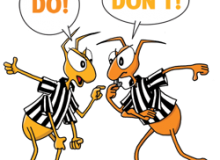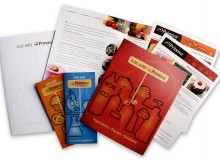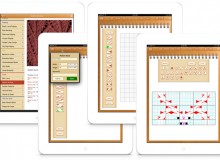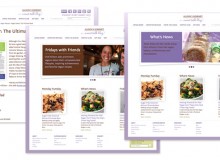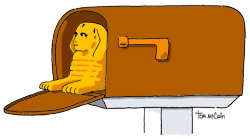 The best thing about a small target of high-potential customers is that you can afford to spend more money on them. In fact, you better, because everyone else is trying to reach them too. If you don’t have something different to say, and a different way of presenting yourself, you’ll get quickly tossed aside.
The best thing about a small target of high-potential customers is that you can afford to spend more money on them. In fact, you better, because everyone else is trying to reach them too. If you don’t have something different to say, and a different way of presenting yourself, you’ll get quickly tossed aside.
That’s why elusive, premium prospects are perfect candidates for three-dimensional packages. So put on your creative hat for a few minutes, and let’s look at how you can make dimensional packages pay off for you.
Why Dimensional Packages Work.
One of the big challenges in moving up the prospect food chain is getting your marketing materials past the admin-assistant gatekeepers. The odds of a postcard or self-mailer making the cut are pretty slim. And electronic alternatives such as email are almost unthinkable unless you’ve established a personal relationship.
What you need is a package that looks personal and stands out from everything else that hits an executive’s desk—or tries to. A box, a tube or other dimensional package that comes personally addressed to the executive, along with a really good headline, is very likely going to get opened. Human curiosity gets the best of all of us, no matter what position we hold. And everyone likes something that seems like a present.
So How Can You Miss?
Easily. Dimensional packages might seem like no brainers (How can you fail with a cushy budget, right?) but just the opposite is true. They need lots of thought and solid creativity to work effectively. To avoid a disaster, let’s look at the two main ways that marketers bring dimensional doom upon themselves:
- Getting caught up in clever. Your dimensional campaign can go down the tubes (no pun intended) just like the entertaining TV commercials that people like but then don’t buy the product. Remember that there’s a business point to be made, and it can’t get totally lost in the fun.
None the less, a dimensional mailer is a big opportunity to be creative. Just remember that you still need to make a case for people wanting to do business with you.
- Coming across as a bribe. This can be a really fine and dangerous line, but error on the side of caution. My personal guideline is $25. As soon as someone perceives the contents to be inappropriately expensive for a promotion, you’re in trouble. Sometimes it’s best to stick with things that relate directly to your business.
For example, I did a dimensional package for a major printer that wanted to reach marketing executives in different sectors. The campaign was multi-stage and went out during the summer with a “grilling” theme. Sales reps got to pick a certain number of prospects that were high potential but contact resistant. Here’s how the program worked:
- Prospects received three envelope mailings over a short period of time with each consisting of a personalized letter and a one-page case history appropriate to the market and service being promoted. The mailings also included a favorite grill recipe from an executive at the printing company, including a picture of the person and a little personal history behind the recipe.
- The final mailing came in a box set and included the popular How to Grill cookbook by Steven Raichlen, a product the printer also happened to print and distribute for its publisher client. So the campaign offered a little fun, came across as executive-to-executive and included a useful tie-in premium that demonstrated the printer’s capability. It also was dynamite at getting the attention of difficult-to-reach executives without overstepping the gift-value component.
Are Dimensional Mailers Strictly for Business-to-Business?
Most are, but that’s primarily a function of being able to more easily whittle down your target in the business sector. But again, dimensional mailers are all about creativity, so don’t necessarily think they’re out of the question if you’re in the consumer space.
A quick simple example is the Republic of Tea catalog, which always includes (or at least mine does) a sample tea packet attached to the cover. It gives the catalog a third dimension, puts it at the top of the pile and gets people to try teas they might never have bought otherwise.
Companies with high-ticket products are also obvious candidates. Manufacturers of luxury automobiles and other premium products can afford to spend more on customer acquisition and have smaller target audiences.
The Time for Dimensional Packages Has Never Been Better?
Although it might sound contradictory, slow economies are ideal for dimensional packages. They force you to do the all-important database work and follow up, help you stand out even more as companies cut back on marketing expenditures and tend to have much higher ROI than conventional direct mail and other marketing efforts.
So start working on that creative brief today.
By Larry Bauer
Want Expert Advice?
MondoVox Creative Group can help you develop dimensional packages that result in sales more ROI. For more information, email Julia Moran Martz.
You can connect with Julia Moran Martz on LinkedIn. Or follow her on Twitter.
